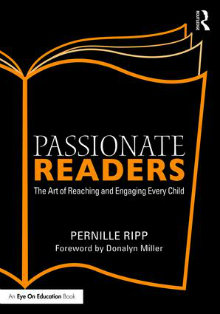Help Every Child Identify As a Passionate Reader
Passionate Readers: The Art of Reaching and Engaging Every Child
By Pernille Ripp
(Routledge/EOE, 2018 – Learn more)

If you are looking for reading strategies or how to teach decoding skills, you won’t find them in Pernille Ripp’s Passionate Readers. That’s because Ripp, a seventh grade Wisconsin teacher who’s also an international speaker, popular blogger and creator of the Global Read Aloud, has a different goal in mind.
Ripp wants her audience to learn the five keys to creating a passionate reading experience so that reading will cease to “suck” for kids, and so that they will create their own reading identities – not ones chosen by adults.

I remembered my first middle school teaching assignment, with five large classes of “remedial” readers. The previous “Reading Specialist” had left worksheets, workbooks, and an SRA kit.
Administrators thought me blessed. But I soon realized I was cursed with student boredom and frustration. The Outsiders had just been published and I used my own money to buy a class set, began to read aloud, start class discussions and role play until kids were begging for more story.
(My author mentor in those days was James Moffett, whose name I don’t see referenced here, but it was more than a few decades ago. If you’re interested in the history of student-centered teaching, Moffett’s Student-Centered Language Arts, K-12 is still a relevation.)
A forever resource
The thoughtful, intelligent, honest Pernille Ripp has given us a book for English and reading teachers that they will want to keep as a “forever resource.” This is a practical guide, full of sample profile and conferring sheets and model letters. She cites experts like Cain for introverted students and Krashen, the expert on silent reading.
Her main constraint is the 45-minute period in which she is challenged to teach everything. This truly is not enough time to fit everything in, and I wish her union, staff, or even parents could persuade powers that be that teachers need more time. But, as Ripp says, we are often “too nice” and simply comply when our professional judgment tells us certain programs and strategies won’t work inside current structures.
Ripp uses her own reader identity to create powerful reading experiences for all her students. Her identity has more to do with her home than school as she grew up (in Denmark and then America) in a house full of books with no censorship. Sadly, she doesn’t remember many teachers or even librarians who were truly in love with books.
Teacher as reading role model
In Chapter One you’ll read about how the idea that she must become a reading role model evolved. She quotes seventh grader Burke: “Teachers can be better reading role models by not acting like they have to read harder books because they’re older, and instead reading books at our level so kids and teachers can connect.” Read about how she makes reading “visible,” even using picture books with secondary kids.
Each chapter has “Questions to Ponder” and “Ideas to Try” so the reader can consider how what Ripp says might apply to them and their own classroom. She encourages readers to be honest about our own reading gaps, slumps, and goals.
Making space for reading
Chapter Two discusses physical space and how it affects our reading experience. Learn how Ripp tries to make the environment welcoming with “tons of good books all over.” She wants to make her classroom a place where kids want to read. Chairs and furniture should be welcoming and safe and create a sense of belonging.
She even changed the sign above her door (“You Matter”) and lets kids design the bulletin boards and arrange furniture. She does set guidelines, however. Students have to be able to move, and arrangements must not be exclusionary. She encourages teachers to make do with what they have.
Building the classroom library
Chapter Three is devoted to the classroom library. Ripp involves her students in selection, arrangement, and sorting of books, reminding us that students live in our classrooms; they’re not just visiting. A variety of diverse books needs to be right in front of kids, and kids should have access to books when they need them.
How do you know which books to buy? Ripp gives numerous suggestions, including Scholastic catalogues, web sites, and simply asking kids what they want. She makes sure comic books and graphic novels are included. Displays should entice. Read how to organize and how to reflect on the best check-out system.
Chapter Four brings up again the challenge of the 45-minute time constraint. Learn about “The 5 Tenets of Choice,” including assessment, and how to start small if choice scares you. Ripp discusses the “top-down” curriculum and how teachers should be able to modify it for their students (and if you don’t know how, just ask them). Her included “Letter to Administrators” is excellent, and don’t skim over “Reading Rules We Would Never Follow as Adults,” on page 83-85. She is not a fan of competitive prizes or Accelerated Reader. Find out why.
A personal journey for students
In Chapter Five, the reader will learn how reading must be a personal journey for students. Some may find the author’s assumptions revolutionary: kids should be able to read what makes them happy. Read Ripp’s “Thens” and “Nows,” as she talks about how beliefs and instruction have changed for her. Learn why we have to “discuss why reading sucks” and tune into the books that kids gravitate toward. She argues that kids know how to choose books.
We don’t need to “level” books for them or offer “pretend choices.” Even audiobooks should count. She separates the books she chooses for silent reading and the ones for teaching decoding skills. She offers some titles that have “clicked” with reluctant readers. Most controversial might be Ripp’s belief that a student’s decision to abandon a book should be “a cause for celebration not disapproval” (see pages 121-128).
What kids, not adults, need
Passionate Readers is mainly about reimagining our reading instruction and making it be about what kids, not adults, need in order to fall in love with books and make reading a life-long pursuit. If I had this book and a new reading or English class, I would begin with “The Reading Identity Challenge Survey” in the Appendix and from there help students with setting reading goals.
This is a book that will make a teacher think and reflect. I’m already following Ripp’s interactive blog where we can all get involved in the discussion. And I definitely think this book should be required reading in all Reading Methods classes.
I hope teachers will let this book challenge and inspire them. If your goal is to get kids to love reading for a lifetime, it’s a lot easier than figuring everything out on your own .
Dr. Mary Langer Thompson taught reading and secondary English for many years before becoming an elementary principal. Her articles, short stories, and poetry appear in various journals and anthologies, and her first children’s book, How the Blue-Tongued Skink got His Blue Tongue, was released last year. In addition to writing in retirement, she teaches writing workshops in schools, prisons, and in her community.


































